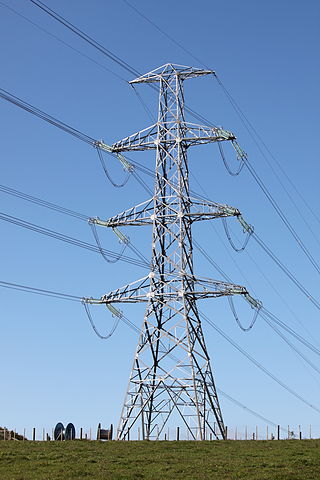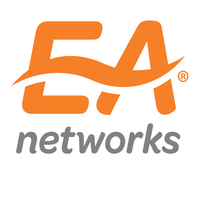Related Research Articles

The electric power industry covers the generation, transmission, distribution and sale of electric power to the general public and industry. The commercial distribution of electric power started in 1882 when electricity was produced for electric lighting. In the 1880s and 1890s, growing economic and safety concerns lead to the regulation of the industry. What was once an expensive novelty limited to the most densely populated areas, reliable and economical electric power has become an essential aspect for normal operation of all elements of developed economies.

A substation is a part of an electrical generation, transmission, and distribution system. Substations transform voltage from high to low, or the reverse, or perform any of several other important functions. Between the generating station and consumer, electric power may flow through several substations at different voltage levels. A substation may include transformers to change voltage levels between high transmission voltages and lower distribution voltages, or at the interconnection of two different transmission voltages. They are a common component of the infrastructure. There are 55,000 substations in the United States.

The Manitoba Hydro-Electric Board, operating as Manitoba Hydro, is the electric power and natural gas utility in the province of Manitoba, Canada. Founded in 1961, it is a provincial Crown Corporation, governed by the Manitoba Hydro-Electric Board and the Manitoba Hydro Act. Today the company operates 16 interconnected generating stations. It has more than 527,000 electric power customers and more than 263,000 natural gas customers. Since most of the electrical energy is provided by hydroelectric power, the utility has low electricity rates. Stations in Northern Manitoba are connected by a HVDC system, the Nelson River Bipole, to customers in the south. The internal staff are members of the Canadian Union of Public Employees Local 998 while the outside workers are members of the International Brotherhood of Electrical Workers Local 2034.

As one of the four power marketing administrations within the U.S. Department of Energy, the Western Area Power Administration (WAPA)'s role is to market wholesale hydropower generated at 57 hydroelectric federal dams operated by the Bureau of Reclamation, United States Army Corps of Engineers and the International Boundary and Water Commission. WAPA delivers this power through a more than 17,000-circuit-mile, high-voltage power transmission system to more than 700 preference power customers across the West. Those customers, in turn, provide retail electric service to more than 40 million consumers. WAPA is headquartered in the Denver, Colorado suburb of Lakewood, Colorado.
Basin Electric Power Cooperative is a wholesale electric generation and transmission cooperative based in North Dakota that provides electricity to 3 million customers in nine U.S. states. The roots of the cooperative go back to 1960 when Leland Olds and ten power suppliers created Giant Power Cooperative. Giant Power was first going to be a generation and transmission cooperative, but to keep electricity cheaper for rural customers, Basin Electric Power Cooperative was started in 1961. Today, Basin Electric's power sources include coal, natural gas, hydroelectric, wind, waste heat, and nuclear. The current CEO and General Manager is Todd Telesz. A subsidiary of Basin Electric, Dakota Gasification Company, operates the Great Plains Synfuels Plant, which captures and sequesters nearly 50% of its carbon dioxide emissions in a system developed during the Carter administration. In 2005, the membership of Basin Electric passed a resolution requiring 10 percent of electricity demand to be provided by renewable forms of energy. At the end of 2009, Basin Electric finished construction on a 77 turbine wind energy project.

The Calcutta Electric Supply Corporation (CESC) is the Kolkata-based flagship company of the RP-Sanjiv Goenka Group, born from the erstwhile RPG Group, under the chairmanship of businessman Sanjiv Goenka. It is an Indian electricity generation and the sole distribution company serving 567 square kilometres (219 sq mi) of area administered by the Kolkata municipal corporation, in the city of Kolkata, as well as parts of Howrah, Hooghly, 24 Parganas (North) and 24 Parganas (South) districts in the state of West Bengal. It also serves power distribution in Kota, Bikaner and Bharatpur in Rajasthan under the name CESC RAJASTHAN. It serves 3.0 million consumers approximately, which includes domestic, industrial and commercial users.

Great River Energy is an electric transmission and generation cooperative in the U.S. state of Minnesota; it is the state's second largest electric utility, based on generating capacity, and the fifth largest generation and transmission cooperative in the U.S. in terms of assets. Great River Energy was formed in 1999 when Cooperative Power Association and United Power Association merged.

Otter Tail Corporation is an energy company based in Fergus Falls, Minnesota. Its subsidiaries include Otter Tail Power Company,BTD Manufacturing Inc.,T.O. Plastics Inc.,Northern Pipe Products Inc., and Vinyltech Corporation.
Path 46, also called West of Colorado River, Arizona-California West-of-the-River Path (WOR), is a set of fourteen high voltage alternating-current transmission lines that are located in southeast California and Nevada up to the Colorado River.

ITC Holdings Corporation is an American energy company which owns and operates high-voltage electricity transmission networks. Headquartered in Novi, Michigan, ITC has operations in Michigan, Illinois, Iowa, Kansas, Minnesota, Missouri, Oklahoma, and Wisconsin. The company is a wholly-owned subsidiary of Canadian energy company Fortis Inc.
MDU Resources Group, Inc. is a U.S.-based corporation supplying products and services to regulated energy delivery and utilities related construction materials and services businesses. It is headquartered in Bismarck, North Dakota, and operates in 48 states.

Amtrak's 25 Hz traction power system is a traction power network for the southern portion of the Northeast Corridor (NEC), the Keystone Corridor, and several branch lines between New York City and Washington D.C. The system was constructed by the Pennsylvania Railroad between 1915 and 1938 before the North American power transmission grid was fully established. This is the reason the system uses 25 Hz, as opposed to 60 Hz, which is the standard for power transmission in North America. In 1976, Amtrak inherited the system from Penn Central, the successor to the Pennsylvania Railroad, along with the rest of the NEC infrastructure.

An electrical grid is an interconnected network for electricity delivery from producers to consumers. Electrical grids consist of power stations, electrical substations to step voltage up or down, electric power transmission to carry power long distances, and lastly electric power distribution to individual customers, where voltage is stepped down again to the required service voltage(s). Electrical grids vary in size and can cover whole countries or continents. From small to large there are microgrids, wide area synchronous grids, and super grids.
Vermont electric power needs are served by over twenty utilities. The largest is Green Mountain Power, a subsidiary of Énergir which recently also took over Central Vermont Public Service. Together this single company represents 70% of the retail customers in Vermont. The state is a small electricity consumer compared with other states. Therefore, its electricity sector has the lowest carbon footprint in the country. As of 2010, the state had the lowest wholesale electricity costs in New England. Efficiency Vermont engages in aggressive initiatives to cut residential electricity waste, which often identifies other problems that it claims can save hundreds per household per year. Accordingly, Vermont's overall energy bills are also relatively lower than in the rest of the New England states.

The provision of electricity in Queensland required a considerable degree of pioneering, innovation, and commitment. Queensland proved to be a pioneer in the supply of electricity in Australia, with the first public demonstration in Australia, the first recorded use for public purposes in the country, the first Parliament House in Australia and the first commercial operations in Australia all occurring in Brisbane.
Wellington Electricity, registered as Wellington Electricity Lines Limited, is an electricity distribution company, based in Wellington, New Zealand.

Electricity Ashburton Limited, trading as EA Networks is a co-operatively-owned electricity distribution company, based in Ashburton, New Zealand.
Otter Tail Power Co. v. United States, 410 U.S. 366 (1973), is a United States Supreme Court decision often cited as the first case in which the Court held violative of the antitrust laws a single firm's refusal to deal with other firms that denied them access to a facility essential to engaging in business.
References
- ↑ "Innovations and Industry Firsts" (PDF). Basin Electric Power Cooperative. Archived from the original (PDF) on 2015-12-22. Retrieved 2015-12-18.